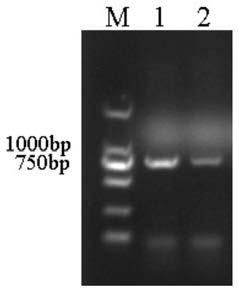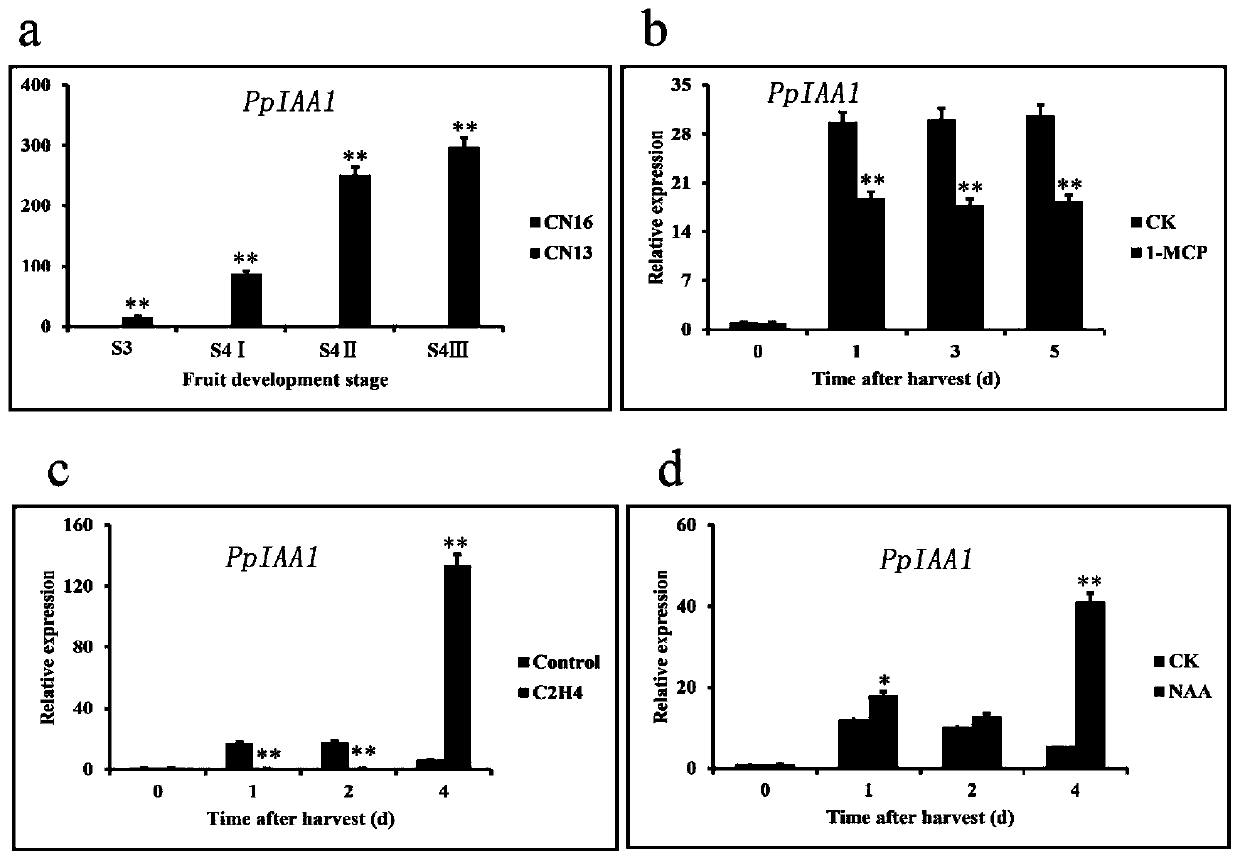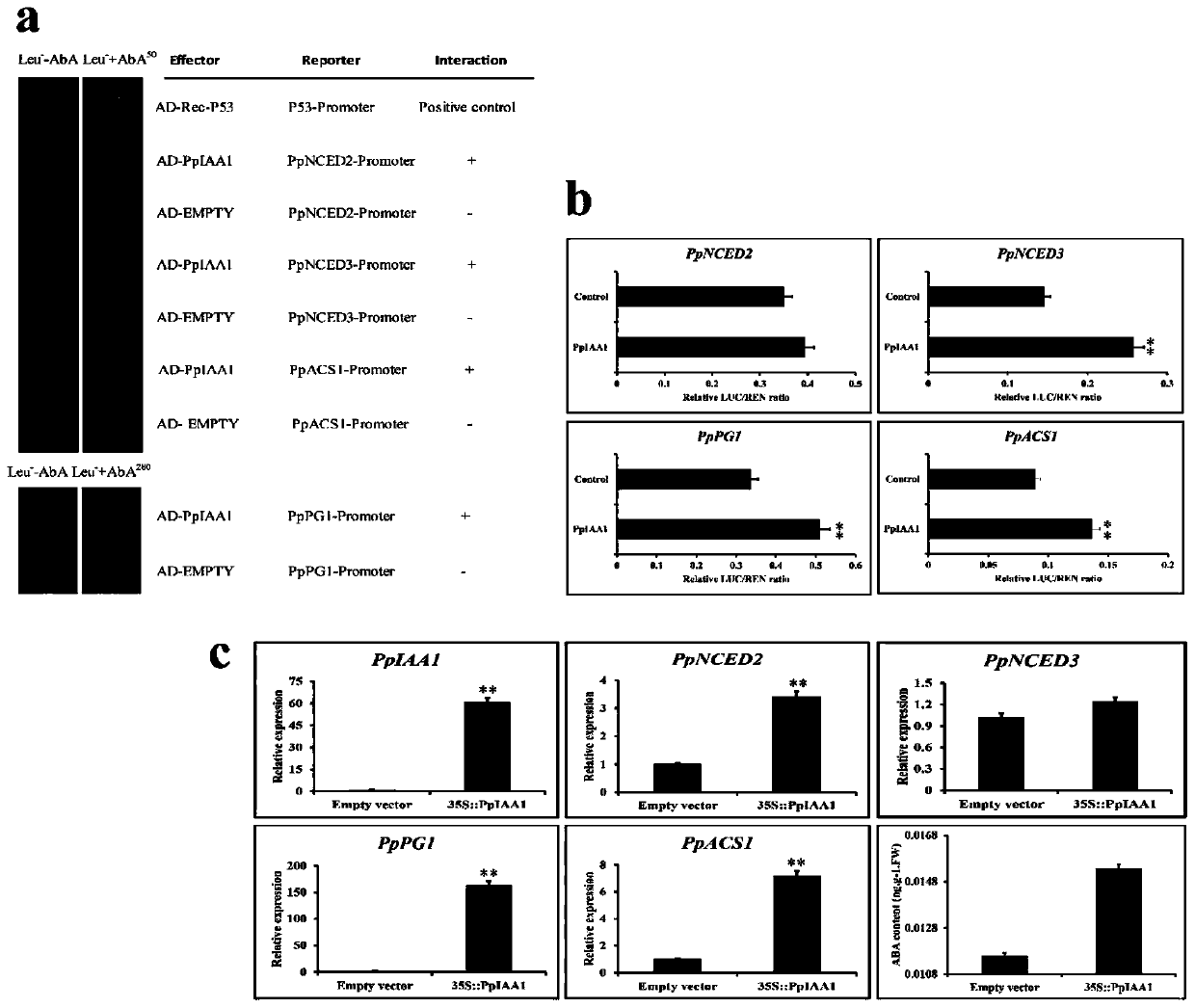Peach auxin primary response factor PpIAA1 gene and application thereof
A technology of response factor and auxin, applied in the fields of application, genetic engineering, plant genetic improvement, etc.
- Summary
- Abstract
- Description
- Claims
- Application Information
AI Technical Summary
Problems solved by technology
Method used
Image
Examples
Embodiment 1
[0045] Example 1 Peach PpIAA1 Isolation and identification of genes
[0046] RNA was extracted from peach pulp with a plant polysaccharide polyphenol kit (DP441, Tiangen, Beijing), and single-stranded cDNA was obtained through a reverse transcription kit (Tiangen, Beijing). The single-stranded cDNA was used as a template and the following sequences were used as primers, Obtained by PCR PpIAA1 The full-length sequence of the gene, as shown in SEQ ID NO: 1, the electropherogram of the PCR amplification product is shown in figure 1 . PCR amplification program: pre-denaturation at 98°C for 3min, denaturation at 98°C for 30s, annealing at 59°C for 30s, extension at 72°C for 30s, 30 cycles; PCR amplification system: upstream primer 0.5ul (10uM / ml), downstream primer 0.5ul ( 10uM / ml), DNA 1ul (20ng / ul), PCR Mix 25ul, the most useful ddH 2 O fill up to 50ul. The primer sequences are:
[0047] Forward IAA1f: 5'-ATGAACATGCCACCGGATGCTG-3', as shown in SEQ ID NO:3;
[0048] Revers...
Embodiment 2
[0052] Example 2 Peach PpIAA1 Gene Expression Analysis
[0053] Detection by qRT-PCR PpIAA1 The expression of genes at different stages of CN13 peach ripening. select Actin ( ppa007242m ) as an internal reference gene, with 2 -ΔΔCt Formula to calculate relative gene expression, qRT-PCR amplification program: pre-denaturation at 95°C for 5 minutes, denaturation at 95°C for 30s, annealing at 60°C for 30s, extension at 72°C for 30s, 45 cycles; qRT-PCR amplification system: upstream primer 0.3ul (10uM / ml), downstream primer 0.3ul (10uM / ml), cDNA 1ul (20ng / ul), Mix 7.5ul, the most useful ddH 2 O fill up to 15ul. Quantitative analysis primer sequence is:
[0054] Forward RTIAA1f: 5'-GGCTGTTGGGATAGCTCCAA-3', as shown in SEQ ID NO:9;
[0055] Reverse RTIAA1r: 5'-GCTTGATCAGTACCATTCATTTCATT-3', shown in SEQ ID NO:10.
[0056] The results show, PpIAA1 The gene was expressed in different ripening stages of CN13 peach fruit, and at the same time PpIAA1 The gene increased rapid...
Embodiment 3
[0057] Example 3 PpIAA1 Gene function identification test
[0058] for research PpIAA1 Whether the gene is involved in the auxin signaling pathway during the peach ripening process was analyzed and identified by transgenic tomato.
[0059] 3.1 Screening of transgenic tomato positive strains
[0060]The tomato transformation method was optimized with reference to Sun et al (2006), Bee Lynn Chew and Yu Pan (University of Nottingham). Micro-Tom tomato seeds were surface-sterilized with 75% alcohol, rinsed with sterile water three times, and then disinfected with 10% sodium hypochlorite for 1 h. After taking it out, wash it 6 times in sterile water and dry it on filter paper. Seeds were sown in 50% MS medium containing 0.8% agar at pH 5.9. Plants were kept in 14 h / 10 h light and dark, 25°C, 80% relative humidity, 250 μmol m -2 the s -1 Cultivate in a tissue culture room with high light intensity.
[0061] To construct the overexpression vector PpIAA1-pK2GW7, use PCR to am...
PUM
 Login to View More
Login to View More Abstract
Description
Claims
Application Information
 Login to View More
Login to View More - R&D
- Intellectual Property
- Life Sciences
- Materials
- Tech Scout
- Unparalleled Data Quality
- Higher Quality Content
- 60% Fewer Hallucinations
Browse by: Latest US Patents, China's latest patents, Technical Efficacy Thesaurus, Application Domain, Technology Topic, Popular Technical Reports.
© 2025 PatSnap. All rights reserved.Legal|Privacy policy|Modern Slavery Act Transparency Statement|Sitemap|About US| Contact US: help@patsnap.com



